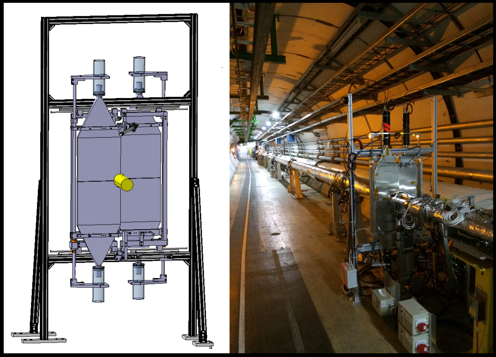The HeRSCheL detector is located not in the LHCb cavern but in the LHC tunnel itself, on both sides of the LHCb interaction point. The detector was built during 2014 and installed at the beginning of 2015 with the goal of enhancing studies of diffractive physics at LHCb. It consists of twenty square plastic scintillators, about 30 cm wide, in which tiny flashes of light are produced when a charged particle passes through. The scintillators are placed within centimetres of the LHC beam, just outside the vacuum pipe, and can therefore be used to detect activity corresponding to particles produced by a particle collision in the main LHCb detector but whose deviation from the beam direction is so small that they escape down the beam-pipe and only emerge further along the tunnel, near the HeRSCheL detectors.
This ability to detect particles at such small angles is crucial for a particular set of measurements made by physicists using LHCb data. These measurements revolve around the study of proton-proton interactions where rather than colliding head-on, the interacting protons merely glance off each other and, in so doing, produce a very small number of particles that can be detected using the standard LHCb detectors and should not lead to activity in HeRSCheL. Somewhat counter-intuitively, then, a proton-proton interaction of interest is one that leads to nothing being detected by HeRSCheL! (a rare occurence, thus allowing HeRSCheL to identify and remove the many interactions that produce significant activity in the detector)

click the image for higher resolution
The HeRSCheL detector is named after Caroline and William Herschel who, together, made great advances in the field of astronomy during the late 18th and early 19th centuries. Not unlike the Herschel family, the HeRSCheL detector brings together well-known and well-established technologies in a novel application. In so doing, HeRSCheL is a valuable extension to LHCb’s physics programme.
